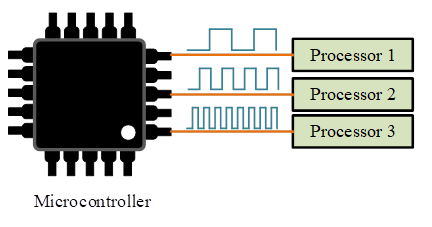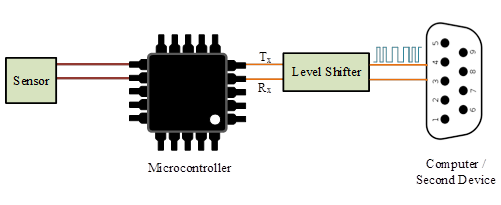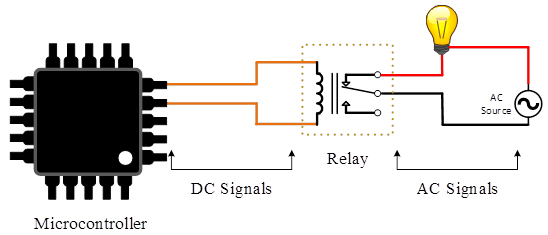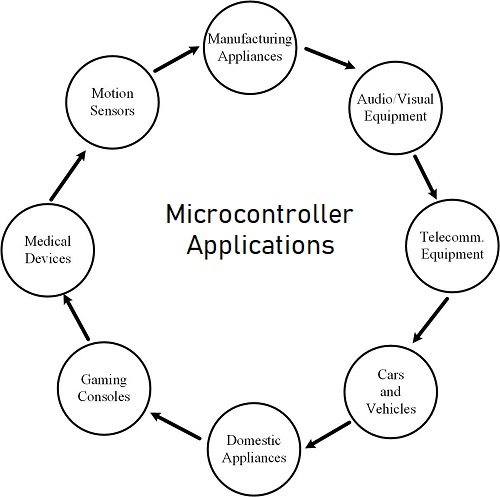This website uses cookies so that we can provide you with the best user experience possible. Cookie information is stored in your browser and performs functions such as recognising you when you return to our website and helping our team to understand which sections of the website you find most interesting and useful.
The Ultimate Guide: Microcontroller Applications
14/05/2021, hardwarebee
In this paper we will describe the most common Microcontroller applications and provide examples of microcontroller usage in different applications. There are various types of microcontroller chips and some are preferred over others in particular applications and scenarios.
A microcontroller (μC) is a single microcomputer chip that has internal peripherals and interfaces. To know about the history of microcontrollers, we must look at the basics, which lead to the development of microcontrollers. The development of metal-oxide-semiconductor field-effect transistor (MOSFET), way back in 1959-60, played a vital role in the origin of microcontrollers. Another great development was the introduction of the integrated circuit concept, which was proposed by Atalla, in the same year. As time progressed the density of MOS transistors kept on increasing as predicted by Moore’s Law.
The first microcontroller was developed by Intel Corporation in 1971, which is called i4004. After this first development, the more advanced version, having more features and memory, was developed and was known as 16-bit 8086 microcontroller. All these developments lead the way to have a more advanced version of microcontrollers (like AVRs) with more control and features.
Microcontroller Overview
Following years of development, various types of the microcontroller are available nowadays. A microcontroller is a compressed computer which can be used to control various components and devices in our daily life. Microcontrollers can be categorized based on different word lengths which are up to 128-bit. The applications include IoT, motor vehicles, home appliances, robotic equipment, and office equipment as well.
The construction of a microcontroller allows the user to have full control of a specific application. A user can automate a small system using a microcontroller. The microcontroller acts as a full control device because it has a processor, peripherals, and a memory to deal with data storage. So, it’s safe to say that any product which has to process some information, stores data that is acquired and processed and displays the information computed, can have a microcontroller chip. The basic structure/components of a microcontroller are:
Central Processing Unit (CPU)
All microcontrollers have a brain which is known as Central Processing Unit (CPU). The task of any CPU is to get the instruction to be executed, analyze it, and perform the required task. In microcontrollers, the instructions are fetched by the CPU from program memory and the required task is performed, after that, the CPU moves to fetch the next instruction.
Memory
Microcontrollers have built-in memory in the form of Flash Memory, ROM, and RAM. These memories are used to store program code, and the data from IO Ports. Different microcontrollers have different sizes of memory, which limits the use of a microcontroller for different applications.
IO Ports
The Input/Output (IO) ports are used to get data from external sources like sensors, user input, etc, and to control external devices including, LEDs, LCD, printers, motors, relays, etc.
Serial Communication Ports
The serial port used in microcontrollers is very useful as it provides a very important interface between different devices. Microcontrollers have different types of serial communication interfaces including UART, SPI, and I2C.
Timers
The timers are an important factor of the microcontrollers. The timers are used in two ways, (i) as a timer to generate pulses, and clock signals and (ii) as a counter which is used to count external events. The timer operation is also linked with the frequency as it works on the microcontroller’s clock.
ADC and DAC Interface
Analog-to-Digital Converter (ADC) can be used to measure analog signals from the sensors. The data is read in the analog form then converted to digital using the ADC function of the microcontroller. Digital-to-Analog (DAC) converter is the opposite of ADC, where the digital data is converted to analog form to drive analog appliances.
Interrupt Control
Interrupts are used to make sure the efficient working of microcontrollers. Interrupts helps microcontrollers to not keep on waiting for a specific signal and do their task in a normal routine. When that signal arrives, an interrupt routine is called, and then after execution of that routine, the program is returned to its original state. The interrupts can be external or internal.
Microcontroller Applications
Microcontrollers can be used in a number of applications including simple applications (like controlling basic devices) to the advanced applications (getting feedback from a device and perform actions based on the feedback). Some of the microcontroller applications are discussed here:
Counting Sequence of Operations
One of the first microcontroller applications is a sequence counter. Microcontrollers have a special feature called “Timers”, which can be used to count sequences of operations. The microcontroller can also decide any operation based on the number of occurrences. This can be illustrated using Figure 1. In this Figure, we assume a “Detector” which sends a low-to-high pulse when a person walks through a gate. The controller counts (using the Time function) the number of persons passed through the gate. When a specific number of persons passed through the gate, the buzzer is activated.
Figure 1: Illustration of counting sequence of operations
Generating Specific Frequency Signals
In real-life applications, there are processes that may require separate clocks to work. In this application, the microcontroller can operate at pre-defined frequencies which might not be helpful at all in some applications. So, the microcontroller provides a feature that uses “Timer” to generate a clock pulse at the output. This clock pulse can be of 1Hz or even higher. In the illustration of Figure 2, a microcontroller generates three different clock signals which drive three different processes.

Figure 2: Illustration of generating different clock pulses
Support Processor for TTL Devices
In general, sensors cannot be interfaced with devices that operate at TTL level e.g. Personal Computers (PC). So, in this application, microcontrollers provide support for the computers. The sensors, either analog or digital, are interfaced with microcontrollers. Once the data received from the sensor is interpreted, it is sent to computers through a serial communication interface. The important thing to remember that microcontrollers work at the CMOS level while computers operate at TTL. So, to transfer data between two types of devices, a level shifter is required to make this happen. A sample diagram is shown in Figure 3, where the data is read from the sensor, and after initial processing, it is sent to a computer.

Figure 3: Illustration of getting data from sensor and sending information to a computer
Controlling AC Devices
Microcontrollers provide an easy way to control AC devices with the help of Relay. This is a slightly more complex microcontroller application as shown before. A simple AC control circuit is shown in Figure 4, where the Light/Bulb can be replaced by any AC device (by changing the right relay). The microcontroller just sends a DC signal to the relay which changes the position of its switch, while on the other end of the relay, the AC devices are connected which can be turned on/off depending on the location of the contact switch. This is the simplest illustration, but using a properly rated relay, one can control an AC device using microcontrollers.

Figure 4: Illustration of how the AC devices can be controlled using microcontrollers
Microwave Control – A Real-Time Microcontroller Application
Microcontrollers can also be used to control different devices, like a microwave oven. As shown in figure 5, the microcontroller can be used to get input from the user to set the time, start and stop the operation. While on the other end, it can display the status on 7-segment displays, can operate the turntable and lamp using relays.

Figure 5: Illustration of a real-life application where the microwave oven can be controlled using microcontrollers
Light Sensing and Controlling Device
As mentioned earlier, microcontrollers are be used to read sensor reading. So, we can interface light sensors, so that we detect light intensity and control the devices like streetlights automatically. This also helps in saving electricity, as the light will never be left on in the daytime.
Temperature Sensing and Control Device
Another microcontroller application using sensors could be the devices that need temperature control like in Air Conditioners. The microcontroller can be used to measure current temperature and depending on the temperature value, the corresponding devices can be turned on or off.
Fire Detection Alarm to Control Room
Microcontrollers can play an important role to take quick action in case of fire. Microcontrollers can detect fire using heat, and smoke sensors. The microcontrollers can be linked directly with the fire department control room using either Wi-Fi, mobile network. In this way, the fire department’s response time can be minimized and the damage could be reduced.
Data Communication
Data communication is a vital part of any system where multiple devices are used. Microcontrollers have multiple protocols to transmit and receive data including Serial Communication, SPI, I2C. The latter helps to communicate between multiple devices, which makes the microcontroller a better choice for communication in devices.
Speedo Meter and Auto Braking
As we know that the vehicles are moving towards self-driving cars. Microcontrollers can be used for a couple of purposes, a speedometer, and auto braking. The ultrasound sensor can be used to detect the speed of the car while the auto-braking algorithm can also be developed based on an ultrasonic sensor.













